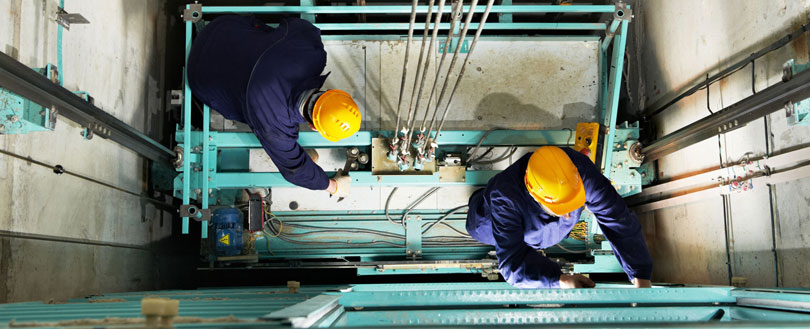Relied On Lift Maintenance Repair Solutions for Reliable Procedure
Wiki Article
Opening the Tricks to Effective Lift Repair Works: Specialist Insights Disclosed
In the realm of lift fixing and maintenance, uncovering the techniques that lead to effective and effective solution is akin to deciphering an intricate challenge. As we get started on this journey to demystify the tricks behind structured lift repair work, a globe of possibilities arises, promising a future where downtime is lessened, safety is prioritized, and operational quality ends up being the standard.Common Lift Repair Service Obstacles

An additional common difficulty in lift fixings is the lack of proper upkeep documents. Without precise maintenance records, repair specialists may have a hard time to diagnose concerns properly or prepare for prospective issues. This can cause longer fixing times and boosted expenses as specialists work to repair problems without historic information to assist them.
Additionally, ease of access issues within lift shafts can posture considerable challenges during repair work. Minimal room, uncomfortable angles, and complex equipment can make it challenging for professionals to get to the required parts for repair service work, lengthening the overall fixing procedure - Lift Maintenance Repair. By resolving these common obstacles proactively, lift repair work specialists can improve functional effectiveness and make certain the smooth performance of upright transport systems
Proactive Maintenance Methods
Executing aggressive maintenance approaches is vital for guaranteeing the long life and optimal performance of lift systems. By taking on an aggressive method to upkeep, building managers and lift upkeep groups can deal with prospective concerns before they rise right into costly repair services or downtime. One reliable strategy is to establish a regular maintenance routine that consists of complete inspections, lubrication of moving components, and testing of security functions.
Furthermore, purchasing training programs for maintenance staff can enhance their skills in recognizing potential issues and performing preventive maintenance jobs properly - Lift Maintenance Repair. By empowering upkeep groups with the expertise and devices required to proactively preserve lift systems, building owners can minimize disruptions, extend the life expectancy of their lifts, and ensure a safe and trustworthy upright transportation experience for residents
Fixing Methods
Effective troubleshooting strategies are necessary for promptly identifying and solving problems with lift systems to minimize downtime and make sure optimal efficiency. One efficient strategy is to try this out start with a detailed visual assessment of the lift parts, checking for any type of noticeable indicators of wear, damage, or misalignment.
Enhancing Repair Service Skills
Enhancing proficiency in lift system repairs is an essential aspect of guaranteeing optimal capability and lessening operational disturbances. Lift specialists must consistently deal with refining their repair work abilities to satisfy the demands of modern-day lift systems. One essential strategy for improving fixing abilities is routine training sessions that concentrate on both academic understanding and practical application. These sessions can cover an array of topics such as brand-new innovations in the industry, repairing complex concerns, and safety methods. Additionally, technicians can take advantage of hands-on experience under the guidance of seasoned experts to boost their problem-solving capacities and decision-making skills in real-time repair situations.In addition, staying updated with the most current improvements in lift technology is important for professionals looking to improve their repair service abilities. This entails proactively seeking info concerning brand-new components, software updates, and maintenance methods to successfully identify and fix concerns. By investing time and initiative right into constant discovering and sensible experience, lift professionals can significantly boost their repair service proficiencies and add to the effective functioning of lift systems.
Elevating Maintenance Standards
Elevating upkeep criteria in lift systems is vital for guaranteeing prolonged functional performance and security. Routine maintenance not only boosts the performance of lift systems but additionally decreases the threat of unforeseen malfunctions and guarantees the safety of users. By sticking to rigorous upkeep procedures, lift owners and drivers can dramatically minimize the learn the facts here now possibility of costly fixings and downtime.Carrying out a thorough upkeep schedule that consists of routine evaluations, lubrication of relocating parts, and proactive substitute of worn components is crucial. Making use of sophisticated technologies like IoT sensing units and predictive upkeep software can aid in keeping track of the lift's condition in real-time, making it possible for prompt treatments before problems escalate. In addition, a knockout post offering continuous training for upkeep team on the most up to date industry standards and ideal practices is vital for maintaining maintenance quality.
Furthermore, cultivating a culture of liability and focus to information among upkeep teams can additionally boost upkeep standards. Motivating open interaction networks for reporting and dealing with maintenance worries without delay can help in preserving a high level of lift system dependability. Inevitably, by focusing on and boosting upkeep criteria, lift systems can run successfully and securely for an extensive duration.
Conclusion
In conclusion, efficient lift repair work call for aggressive upkeep strategies, troubleshooting techniques, and enhanced repair abilities. By addressing common obstacles and boosting upkeep requirements, maintenance professionals can effectively ensure the smooth procedure of lifts - Lift Maintenance Repair. Carrying out these professional insights can result in improved efficiency, lowered downtime, and raised security for both travelers and devicesIn the realm of lift repair work and maintenance, revealing the methods that lead to effective and effective service is comparable to decoding an intricate challenge.Another widespread difficulty in lift repairs is the absence of appropriate maintenance documents. By embracing a positive method to upkeep, building supervisors and lift upkeep teams can resolve prospective issues prior to they intensify into pricey repair services or downtime.In final thought, reliable lift repair services require positive maintenance techniques, troubleshooting strategies, and boosted repair work abilities. By attending to common difficulties and elevating maintenance requirements, upkeep professionals can properly ensure the smooth procedure of lifts.
Report this wiki page